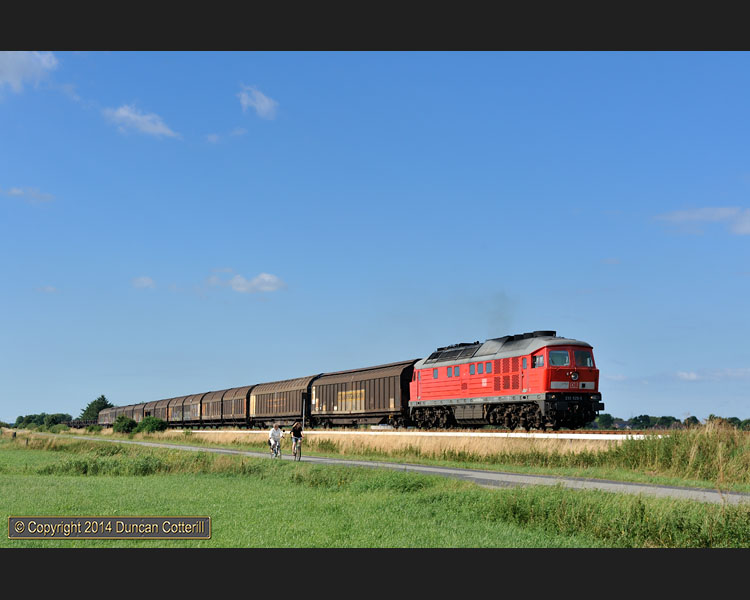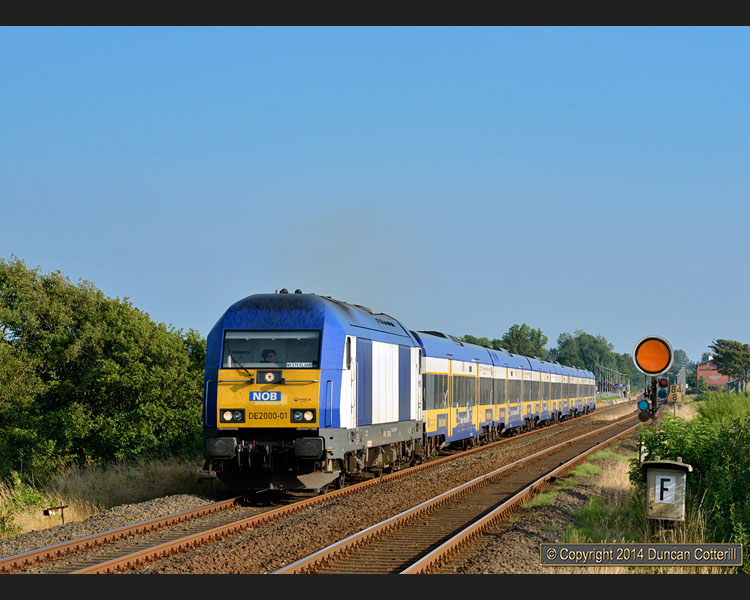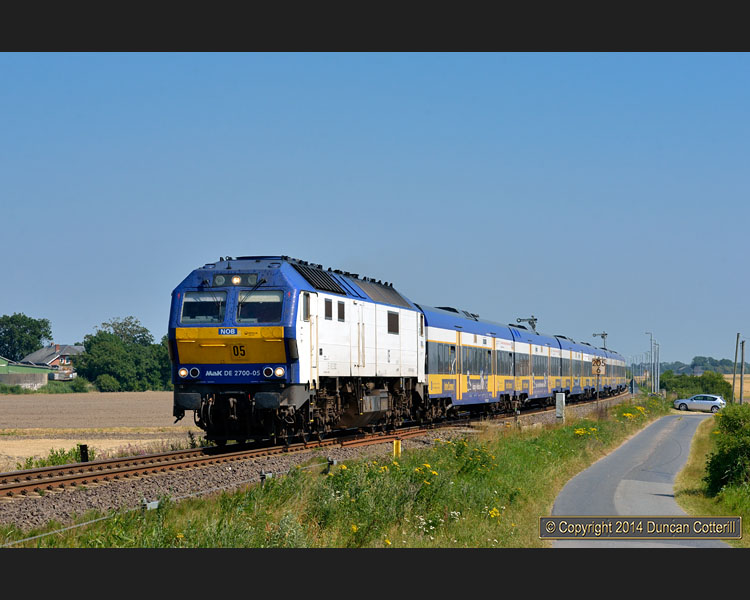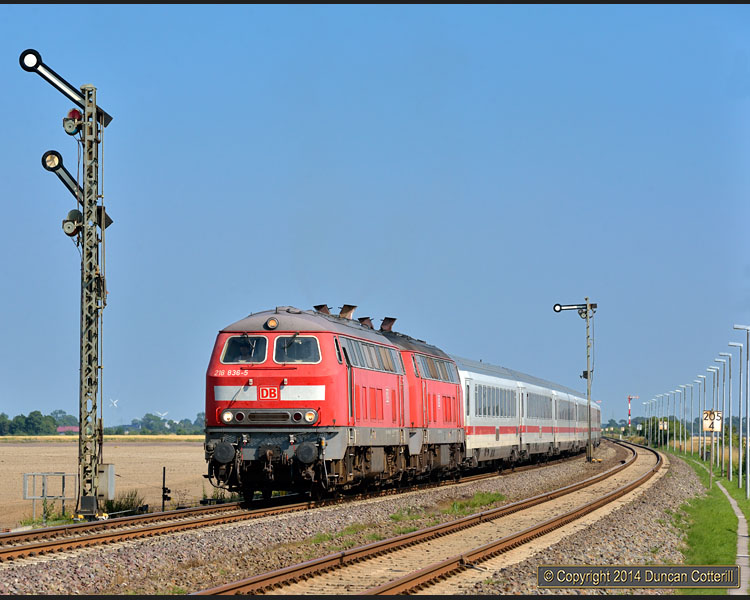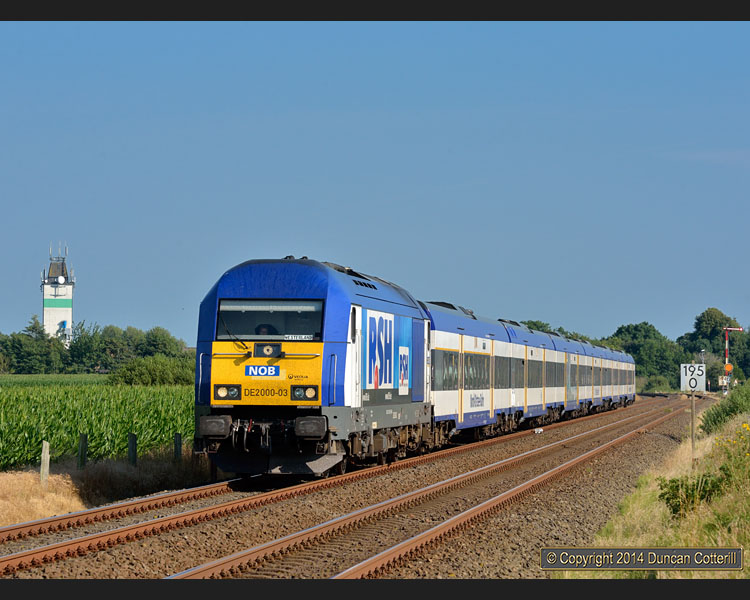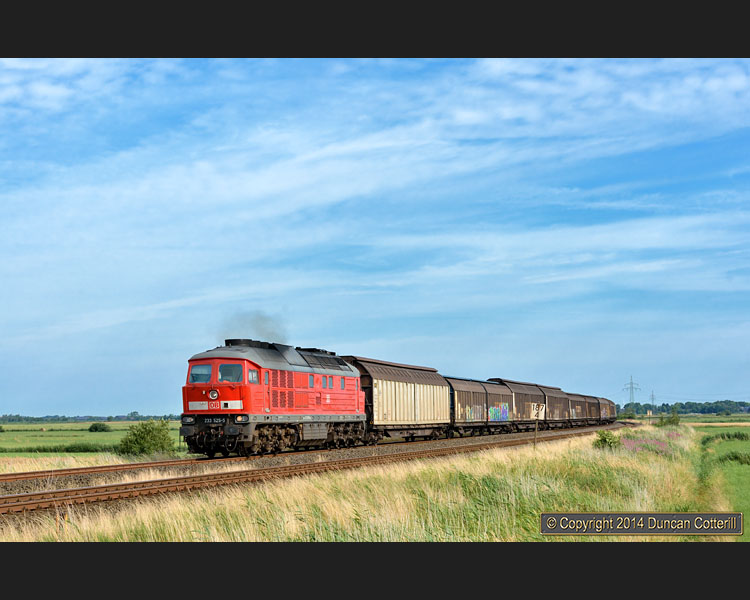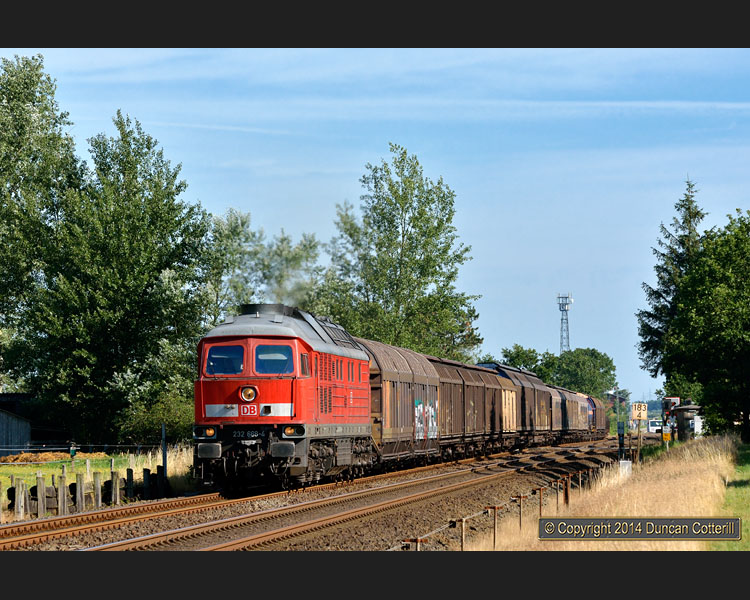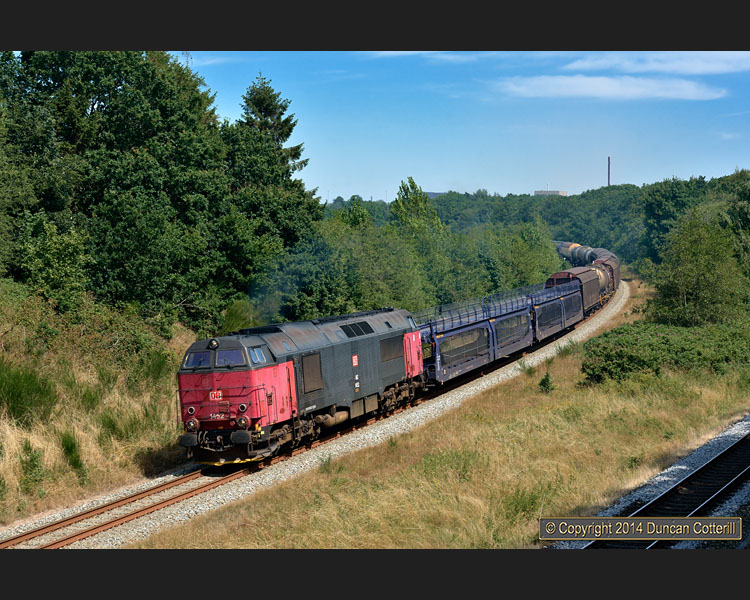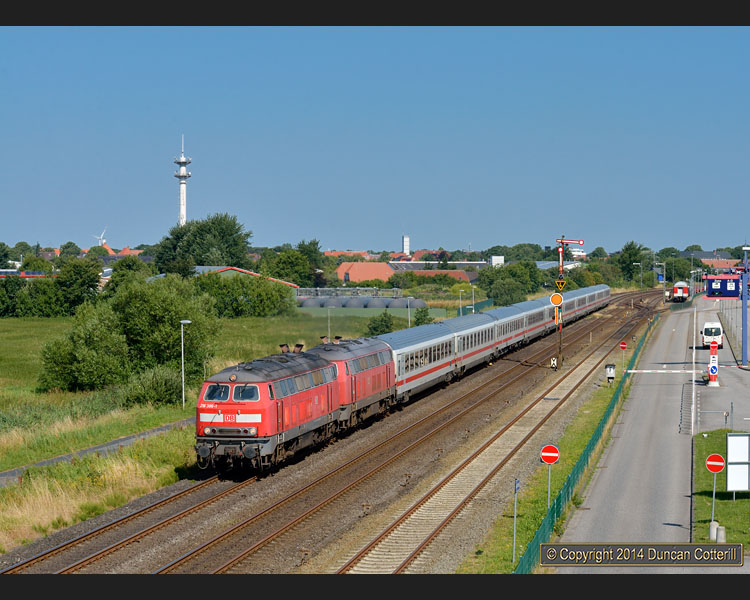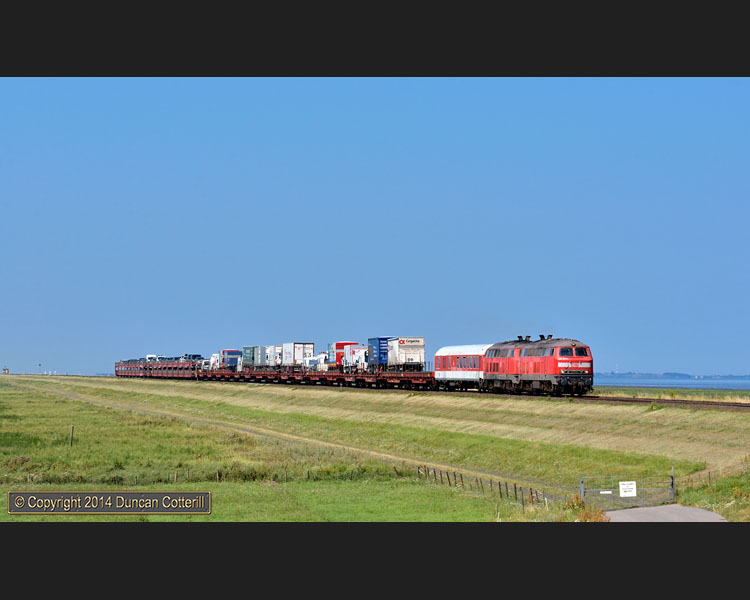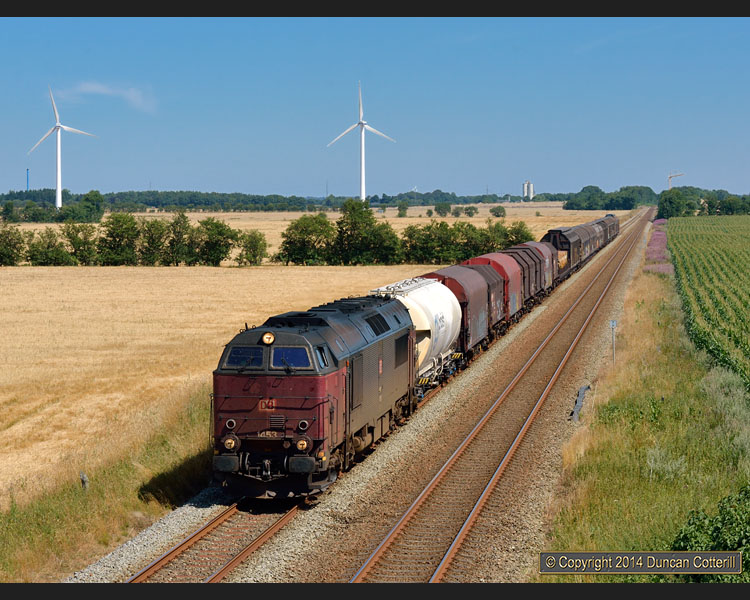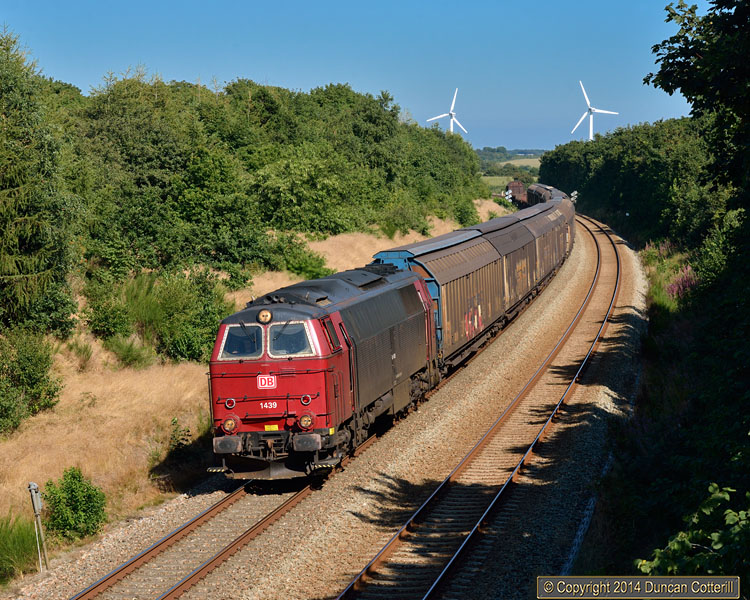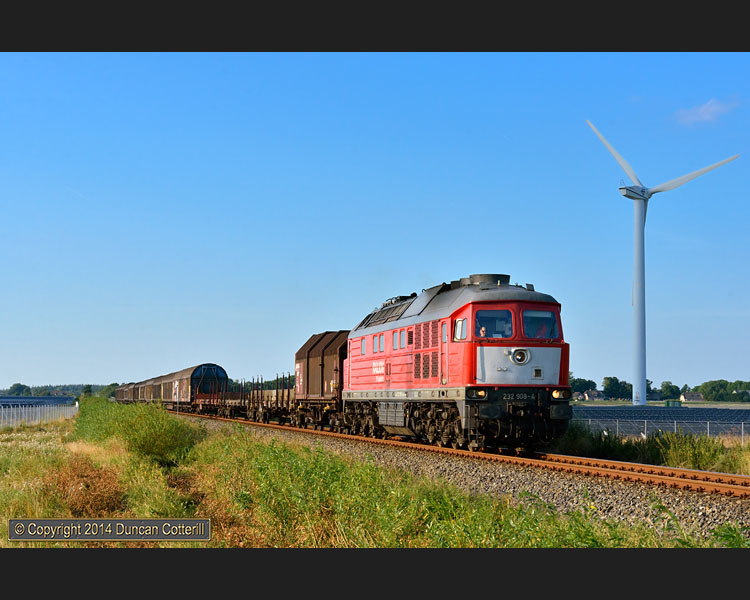THE JUTLAND CAMPAIGN
Diesel Freight Diversions on the Marschbahn and in Southern Denmark
Germany and Denmark - 15 to 24 July 2014 - Report by Duncan Cotterill
INTRODUCTION
Major engineering work on the main line between Lunderskov and Padborg in southern Denmark resulted in the closure of the principal rail link between Denmark and northern Germany for three weeks in July and early August 2014. Passengers had to suffer the indignity of bus substitutions, leaving freight traffic to take a long diversionary route from Lunderskov, via Esbjerg, the little used Tønder – Niebüll border crossing and the Marschbahn south to Elmshorn, just north of Hamburg. Apart from the last 34 km from Itzehoe to Elmshorn, the whole 320km route is unelectrified and significant sections are single track.
The Marschbahn is already one of the last strongholds of diesel haulage in Germany with plenty of loco hauled passengers and a car carrying operation between the mainland and the island of Sylt. Add in some freights and the prospect of getting some pics in Denmark, a new country for me, and the lure became irresistible.
I flew from Gatwick to Hamburg with easyJet and hired a car for the duration. My base for the trip was the Gastätte Bongsiel at Ockholm, not far from Niebüll.
THE LINE
From the end of electrification at Itzehoe (km 64.9 from Hamburg-Altona), the double track line takes a circuitous route to St. Michaelisdonn (km 101.2) before heading almost due north for another 110km to the Danish border via the towns of Heide, Husum and Niebüll. The landscape is very, very flat with no significant hills anywhere near the line but there are plenty of trees, towns and villages to break the monotony, not to mention a growing forest of wind turbines and fields full of solar panels.
There are a number of interesting features along the way, of which the most impressive is the Hochbrücke Hochdonn, a massive steel bridge that soars high over the Kiel Canal (or Nord-Ostsee Kanal as it’s known locally). The bridge, around 12km south of St. Michaelisdonn, is over 2km long and at 42m above the canal, allows sea-going vessels to pass underneath.
There’s another major bridge between Lunden (km 140.8) and Friedrichstadt (km 147.1) where the line crosses the Eider estuary on a 400m long single track bridge with a swing span to allow river traffic to pass. The line goes from double track to single immediately before the bridge, then back to double immediately afterwards.
The line singles again for a short distance to cross a lifting span over the harbour at Husum, just north of the station (km 158.3).
There are junctions with branches to Büsum and Neumünster at Heide (km 124.5), to Bad St. Peter Ording at Horn (km 153.6) and to Jübek, on the Hamburg – Kiel main line, at Husum.
The 11km section from Hattstedt (km 165.8) to Bredstedt (km 176.8) is also single track and a significant bottleneck when it comes to operations. From the next station, Langenhorn (km 184.3), all the way to the end of the line at Westerland, semaphore signals are the norm.
From Niebüll (km 198.5) the original Marschbahn continued north for another 18km to Tondern (Tønder), now in Denmark but then under German rule, where it connected with an existing branch to Hoyer (Højer) and a ferry connection to the island of Sylt. After the Schleswig-Holstein referendum of 1920, the German – Danish border was redrawn with northern Schleswig, including Tønder and Højer opting to be part of Denmark, while southern Schleswig decided to stay with Germany. That meant travellers from Hamburg to the popular holiday island of Sylt needed to cross two international borders to reach their destination. A solution was found by building a causeway, the Hindenburgdamm, across the 8km of the shallow Wattenmeer (Wadden Sea) between the mainland and the island and extending the Niebüll – Klanxbüll branch all the way to Westerland, on the far side of Sylt. Westerland (km 237.7) has been the northern terminus of the Marschbahn since the opening of the causeway in 1927.
The 29km section between Niebüll and Westerland is undoubtedly the busiest part of the Marschbahn but is single track except for the 17km double track section between Klanxbüll (km 211.7) and Morsum (km 228.8), which includes the Hindenburgdamm. There is an intermediate loop at Lehnshallig (km 205.1) and a loop at Keitum station (km 233.3). There’s also a signalbox in the middle of the Hindenburgdamm itself, equipped with colour lights. All the other signalling in the area is semaphore, including Westerland itself.
Compared with the wonders of the Marschbahn, the route north from Niebüll across the border to Tønder and on to Bramming, where it joins the Esbjerg – Lunderskov main line, isn’t very exciting. There’s a semaphore guarding the approach to Niebüll but the rest of the line is equipped with colour lights and there are no significant civil engineering structures en-route. The line is single track with passing loops at Süderlugum (9.6km north of Niebüll), Tønder (km 64 from Bramming), Bredebro (km 49), Skærbæk(km 36.7), Ribe (km 16.7) and Gredstedbro (km 8.5).
When the line was built in the 1880s, the Danish/German border was around 6km south of Ribe and most of the route was in Germany. From shortly after opening until 1920 the line south of the border station of Vedsted/Hviding was part of the KPEV system, passing to DSB when northern Schleswig voted to join Denmark. Scenically, this part of Denmark is almost as flat as the German section further south, with huge fields and mechanised agriculture predominant but also a fair number of trees and wind turbines.
The main line between Esbjerg and Lunderskov is also unremarkable, being double track, signalled with colour lights and devoid of significant civil engineering works. Again the countryside is fairly flat but undulates enough to require cuttings and embankments in places. Land use is no different but the line does run almost due east-west instead of due north-south.
PASSENGER TRAINS
Only one loco hauled passenger train was seen in Denmark and that was clearly a special, consisting of two old coaches being hauled west on the Fredericia – Esbjerg line on Wed 23rd by a class MT centre cab Bo’-Bo’ in green livery and numbered 152.
All the remaining passenger trains seen were operated by DMUs but there were a variety of types. The hourly InterCity services between Esbjerg and Østerport, north of København, were operated by class MF (IC3) 3-car units, usually operating singly, although the occasional 6-car formation was also seen. On Sunday 20th, the hourly Esbjerg – Fredericia local services were operated by older class MR 2-car units but on my later visits on Tue 22nd and Wed 23rd the new class MG (IC4) units were being used, demoted from InterCity work before they’d even started.
Passenger services between Esbjerg and Tønder are operated by Arriva Denmark, ironically now owned by DB, using class AR 2-car Alstom Lint 41 DMUs. For the duration of the freight diversions most services were only running between Esbjerg and Ribe with a couple of trains a day continuing to Tønder and the rest replaced by buses. Under normal circumstances, some of these trains would have continued over the border from Tønder to Niebüll, operated in Germany by NEG, the Norddeutsche Eisenbahn Gesellschaft, but all cross border services were bustituted for the duration.
Things are very different in Germany with virtually every train on the Marschbahn loco worked, although many are propelled and some have the loco sandwiched between two outward facing push-pull sets.
Regional services on the Marschbahn are operated by the Veolia subsidiary Nord-Ostsee Bahn, with an acronym to delight every schoolboy. It’s noticeable that the Germans pronounce it as three letters rather than a word – maybe it’s considered rude in German as well? The local service between Itzehoe and Heide was operated by 2-car Talent DMUs but every other NOB train seen was loco worked.
There’s a sort of regular interval pattern in operation with hourly trains running most of the day between Hamburg-Altona and Westerland. There are a number of extra services running all or part of the way and other trains shifted by 30 minutes from the hourly pattern to make room for InterCity services, making the interval half hourly at busier times. The usual formation for NOB services is a 6-coach single-deck push-pull set with the loco at the north end but some services were strengthened by the addition of a north facing 4-car push-pull set ahead of the loco, making a 10-coach push-push set.
There were some variations, such as on Fri 19th and Sat 20th a 10 car formation comprising a 6 car and a 4 car set coupled together was being hauled in both directions. These trains are now understood to be through workings to/from Köln in conjunction with HKX. On Thu 24th one train was seen running with the loco on the south end of a 4-car set in pull mode going south and later pushing northbound.
A variety of locos were in use including five of the class 251 Co’-Co’ diesels, also known as DE2700. These were the locos built in the mid 1990s by Siemens for Norway as class Di.6 but rejected by NSB. 251.001, 003, 005, 007 and 008 were seen in use, all registered to Veolia (D-VL). according to www.privat-bahn.de NOB also have 251.010, 011 and 012 but none of these appeared during my 10 day visit. Three Siemens ER20, also known as DE2000, registered to NOB (D-NOB) were in use, 223.053, 054 and 055, as were four more belonging to MRCE Displolok (D-DISPO), 223.001, 010, 011, 013. Of the four Dispos, only 223.013 carried the current black livery, the remainder were in the original yellow and silver, which is now looking a bit tired.
There didn’t seem to be much of a pattern to which trains would be worked by 223s and which 251s. Neither was there much of a pattern to which trains would have the loco mid-train, except that only class 251s were used mid-train. Only one or two locos would be seen operating mid-train each day and then sometimes only for part of the day.
NOB services were generally punctual but on several occasions there were quite severe delays with a train running well over 30 minutes late, usually followed by the next service a few minutes later. The reasons for these delays are unknown but usually only one or two trains were seriously affected with the service quickly getting back to normal afterwards.
Four InterCity services each way a day link Westerland with Hamburg and points south including Dresden, Frankfurt and Stuttgart. These trains are diesel hauled north of Hamburg or Itzehoe by pairs of class 218 diesels and most convey a portion serving Dagebüll Mole, attached to a NEG railcar between Dagebüll and Niebüll. IC services originating at Westerland were generally fairly punctual but those coming the other way were more likely to be delayed, although usually only by 10 minutes or so.
A total of seventeen different locos were seen on IC trains;
218.307, 314, 315, 321, 322, 344, 345, 359, 362, 363, 372, 376, 380, 381, 386, 397, 836. Note that around half of these locos were also seen on car shuttles.
SYLT SHUTTLES
Somewhere in the grey area between passenger and freight trains are the SyltShuttle workings between Niebüll and Westerland. There’s no road access to Sylt so DB operates car carrier trains across the Hindenburgdamm carrying cars, vans and even complete articulated lorries. Each train consists of a number of double-deck articulated car carriers, a number of flat wagons for the larger vehicles and a coach converted to carry motorcycles. Drivers and passengers travel in their vehicles. Pairs of DB class 218 diesels provide haulage.
The basic service is hourly from early morning to late evening with trains at half hourly intervals during busier periods, meaning most of the day on summer weekends as well as the normal weekday peak hours.
Sixteen different 218s were seen on SyltShuttle workings;
218.311, 313, 315, 319, 322, 341, 342, 359, 362, 364, 371, 372, 376, 380, 381, 389
Although the locos worked in pairs, they seemed to swap partners fairly often and around half of them were also seen on InterCity workings at one time or another.
FREIGHT TRAFFIC
Around a dozen trains each way a day were scheduled to be diverted via the Marschbahn and Esbjerg every day during the period of the Lunderskov – Padborg closures, all worked by DBS, the main freight operator in Denmark as well as Germany. Ex DSB class MZ Co’-Co’ diesels would take over from electrics at Fredericia, or the nearby junction of Taulov, and work the trains west to Esbjerg, a distance of around 70km. The MZs seemed capable of keeping up with the passenger schedules but were usually slotted in behind either of the hourly passengers. Most trains were single headed but on Wed 23rd two double headed eastbounds were seen, almost certainly returning locos east as quickly as possible to pick up their next westbound train. I was surprised that the locos, despite carrying DB logos, were registered to DK-RSC but it turned out this wasn’t the Royal Shakespeare Company but DB Schenker Rail Scandinavia. Six different MZs, most of the DBS fleet, were seen in use; 1439, 1449, 1452, 1453, 1456 & 1459, with 1439, the only series III loco, looking quite smart and most of the others, all Series IV locos, fairly grimy. One loco, 1449, was badly graffitied.
From Esbjerg, DB class 232 or 233 Co’-Co’ diesels took over and worked trains south into Germany. The Ludmillas aren’t fitted with Danish safety systems and were severely speed restricted over the first 15km or so, between Esbjerg and the junction of the Fredericia and Tønder lines at Bramming, usually trundling along around 30km/h. Once on the single track south of Bramming they speeded up considerably and rattled along happily at around 80km/h. Normal practice seemed to be for the German driver to work through but to take a Danish pilotman between Esbjerg and Tønder.
Once over the border and into Niebüll, pathing became a significant problem, especially the need to slot in between the frequent passenger trains on the single track section between Bredstedt and Hattstedt, north of Husum. A typical southbound freight would follow a southbound NOB service from Niebüll, arriving at Bredstedt as the passenger cleared Hattstedt and clearing the single track itself before the northbound NOB service arrived. Northbound freights tended to follow a northbound NOB service from Itzehoe. Faster freights would still be right behind the NOB service all the way to Niebüll but slower freights needed most of the hour before the next NOB service to complete the journey. When the passenger service was more frequent, northbound freights were in danger of being caught up by the following passenger long before reaching Niebüll and southbounds before Itzehoe. A lack of loops made overtaking difficult and relatively few freights were scheduled during the busier periods for passenger traffic.
The Husum – Jübek line provides an alternative route across to the Kiel – Hamburg main line, avoiding the south end of the Marschbahn, and a number of freights were scheduled to go this way, running down the main line to Neumünster and changing locos there. The Jübek line doesn’t have the capacity to handle freights when the hourly daytime passengers are running but some evening services were bustituted for the duration of the diversions, allowing evening or overnight freights to run this way. A number of evening trains had two sets of timings, one via Jübek and the other via Itzehoe but it’s not known how often each route was used.
In general freights ran fairly close to their booked times. Passing times at Langenhorn, the first station south of Niebüll, were monitored whenever I was there or close enough to calculate a sensible time. Out of 50 trains recorded, 29 were within 10 minutes of right time and 47 were within 30 minutes, with northbounds better timekeepers than southbounds overall. Only one of the booked trains, 47412, 14:18 from Itzehoe, was a regular no show, only appearing once in ten days. The others turned up more often than not. There was a significant deviation from the timetable on the last morning, Thu 24th, when two additional southbounds were seen in the morning, slotting into what’s normally a 3-hour gap between the 09:05 and 12:05 southbound departures from Niebüll.
Eighteen different Ludmillas were seen, 13 232s and 5 233s;
232.201, 230, 241, 384, 388, 469, 472, 534, 568, 587, 668, 669, 908,
233.233, 285, 321, 525, 662.
They didn’t all appear to be there at the same time but gradually changed over the course of the ten days.
In addition to the diverted international freights, a number of local workings were seen. Vossloh G1206 275.016 was seen in the Niebüll area on a number of occasions during the trip. The loco is also numbered 1510, carries CFL Cargo branding and is registered with B&V Leipzig GmbH (D-BUVL). On Thu 17th it worked a long train of tank containers south through Langenhorn in the early evening. On Mon 21st it was seen heading from Westerland to Niebüll with a mixed freight in the middle of the afternoon and later leaving Niebüll for the south after shunting. It’s been pointed out that NEG, operators of the branch from Niebüll to Dagebüll are owned by CFL and the loco may be based at NEG’s Niebüll depot for working local freight trips.
A pair of DB Infrastructure class 203s (203.301, 306) worked north with a short departmental train on Wed 16th and were seen north of Langenhorn at midday. The locos went back south, light engine, the following morning.
Much further south, between Itzehoe and Heide, two short freights hauled by unidentified DB class 261 diesels were seen heading towards Itzehoe within 15 minutes of each other at lunchtime on Thu 24th.
PHOTOGRAPHY
Having never visited the Marschbahn or western Denmark before, I didn’t really know what to expect photographically. Pictures found on the internet weren’t particularly inspiring and there’s a limit to how much information could be gleaned from Google Maps. A poor weather forecast on the first day of the trip was the perfect excuse to travel the line from Itzehoe to Westerland and back in an attempt to find some decent locations. The opportunity was also taken to buy a couple of detailed maps before leaving Itzehoe and these proved to be very useful. There weren’t many promising spots south of Husum but a few places to the north looked more hopeful and some of them turned out to be rather good, particularly those around Langenhorn.
One of the biggest problems was a lack of height. The line generally runs across the plains on low embankments, two to three metres high, presumably as a defence against flooding. With no higher ground to stand on, it was very difficult to get above rail level or, more importantly, trackside weed level, for long stretches.
The other big problem was that the direction of the line hardly varied from due north-south, so a lot of trains were next to impossible to photograph as the light wasn’t right anywhere. Other trains were right for the light in many different places but you could only be in one location for each train. Even with a fast car chasing was impractical unless you knew the train had to stop somewhere.
The Niebüll – Westerland line, running SE-NW and then E-W, offered somewhere to go when the light was wrong south of Niebüll. There were no Ludmilla hauled freights, of course, but with ICs, SyltShuttles and semaphores it was a more than acceptable substitute.
When photographing trains in a flat landscape, it’s important to find things to fill the frame. A few pictures with a train, a big sky and nothing else are OK but nobody would want to look at dozens of them. The semaphore signals were a great help in this respect but otherwise it was necessary to look for trees and even wind turbines to add a bit of interest.
The Lunderskov - Esbjerg section was explored on another poor weather day, using only a satnav to navigate from one crossing or bridge to the next and noting the ones that were worth returning to. In the event, it turned out to be fairly straightforward with a few overbridges between Lunderskov and Vejen and a few more between Bramming and Esbjerg providing reasonable vantage points for westbound trains. I didn’t find a single shot that was really good for eastbounds.
The Bramming – Tønder – Niebüll line wasn’t really explored in detail but I did stumble across a couple of reasonable spots on the Danish section while returning from the Esbjerg area on Tue 22nd and Wed 23rd. In both cases I knew a train wasn’t far away so it was a case of taking off down a side road and hoping for the best. A couple of reasonable spots were also found between the border and Niebüll.
Knowing that the weather in northern Europe was likely to be mixed at best and could have been cloudy for days on end, I decided to go for ten days on the basis that I could reasonably hope for a couple of good sunny days. In reality, it was sunny about 70% of the time but it still took the whole trip to get most of the pictures I wanted.
COMMENTS AND CONCLUSIONS
It was good to see an intensive diesel freight operation in Germany again and the number and quality of pictures obtained comfortably exceeded my expectations. The fact that trains ran to schedule was a great help and made it possible to plan when to be in position and when to move without missing too many trains.
The diverted freights were the icing on the cake but the cake itself was impressive. With NOB and InterCity passengers, SyltShuttle car carriers and a little local freight, there are normally plenty of loco hauled trains to photograph on the Marschbahn. The variety of different classes and some interesting locations mean its well worth a visit, even without the diversions. Indications are that there will be diversions next summer as well, let's hope so.
It’s also a line that’s well suited to doing by rail, with many of the good locations within a couple of km of stations. A car is still useful to get to some of the more remote locations, such as the east end of the Hindenburgdamm or the Hochdonn Hochbrücke but it’s possible to do a lot on foot without too much effort. Hiring a bike would make access to even more locations practical.
If you’re contemplating a visit then don’t wait too long. The NOB contract is coming up for renewal at the end of next year and I was told that whoever wins, they’ll be using new Traxx ME locos instead of the current mixture of 223s and 251s. The DB 218s on InterCity and SyltShuttle trains won’t last forever and neither will the semaphore signals. Get them while you can.
I’d like to say that the Danish sections would be worth visiting once the freights have finished but there wouldn’t be a lot to photograph on the Fredericia – Esbjerg and Bramming – Tønder lines, just DMUs. Preparatory work for electrification is currently underway between Lunderskov and Esbjerg and poling will ruin most of the few locations that currently exist. It’s a great shame really as Denmark seemed a very pleasant place to visit. A return will be a high priority if the diversions are repeated next year and a trip to the east to photograph MEs might possibly be on the cards.
Finally, thanks to Phil Wormald for the original heads up and the timings, to Neil Aitken for helping make sense of the CFL G1206 at Niebüll and to the Danish guys who helped with a couple of photo locations. And a big hello to the York crew. Hope the day trip to the Rhein Valley went OK!
